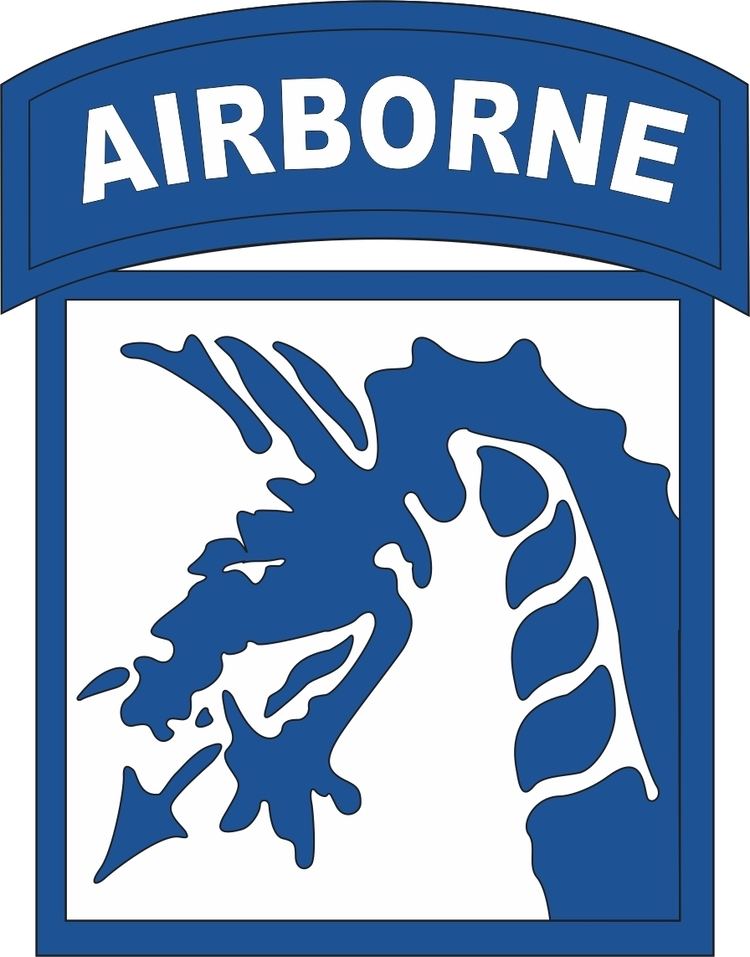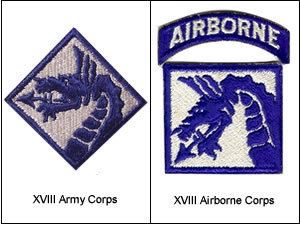Active 1942–19451951–present Current commander LTG Stephen J. Townsend Founded 1942 | Motto Sky Dragons | |
 | ||
Similar VII Corps, III Corps, V Corps, United States Army Cen, First Allied Airborne Army Profiles | ||
The XVIII Airborne Corps is a corps of the United States Army that has been in existence since 1942 and saw extensive service during World War II. The corps is designed for rapid deployment anywhere in the world and is referred to as "America's Contingency Corps". Its headquarters are at Fort Bragg, North Carolina.
Contents
- Xviii airborne corps night jump
- World War II
- World War II units
- Cold War to Desert Storm
- Units Post World War II through 2006
- 21st century
- Current structure
- Operations
- Notable members
- References

Its command group includes:
Xviii airborne corps night jump
World War II

The corps was first activated on 17 January 1942, five weeks after the entry of the United States into World War II, as the II Armored Corps at Camp Polk, Louisiana, under the command of Major General William Henry Harrison Morris, Jr.. When the concept of armored corps proved unnecessary, II Armored Corps was re-designated as XVIII Corps on 9 October 1943 at the Presidio of Monterey, California.

XVIII Corps deployed to Europe on 17 August 1944 and became the XVIII Airborne Corps on 25 August 1944 at Osbourne, St. George, England, assuming command of the 82nd and 101st Airborne Divisions, as part of the preparation for Operation Market Garden. Prior to this time the two divisions were assigned to VII Corps and jumped into Normandy during Operation Overlord, the Allied invasion of Normandy, as part of VII Corps. Major General Matthew Bunker Ridgway, a highly professional, competent and experienced airborne commander who had led the 82nd Airborne Division in Sicily, Italy and Normandy, was chosen to command the corps, which then consisted of the 82nd and 101st Airborne Divisions and was part of the newly created First Allied Airborne Army.
The corps was unable to see service in Operation Market Garden, with the British I Airborne Corps being chosen instead. Following the Battle of the Bulge, in which the corps played a significant part (and which, during the early stages of the battle, the corps was commanded by Major General James M. Gavin of the 82nd Airborne), all American airborne units on the Western Front fell under command of the corps. XVIII Airborne Corps planned and executed Operation Varsity, the airborne component of Operation Plunder, the crossing of the River Rhine into Germany. It was one of the largest airborne operations of the war, with the British 6th and U.S. 17th Airborne Divisions under command. The U.S. 13th Airborne Division was to participate in the assault. However, due to a lack of a sufficient number of transports, the division was unable to take part. After taking part in the Western Allied invasion of Germany, the XVIII Airborne Corps, still under Ridgway, returned to the United States in June 1945 and was initially to take part in the invasion of Japan, codenamed Operation Downfall. However, the Japanese surrendered just weeks later and XVIII Airborne Corps was inactivated on 15 October 1945 at Fort Campbell, Kentucky.
World War II units
Cold War to Desert Storm
The corps was reactivated at Fort Bragg on 21 May 1951 under the command of Major General John W. Leonard. Since then, the corps has been the primary strategic response force, with subordinate units participating in over a dozen major operations (listed below) in both combat and humanitarian roles, primarily in Central America and the CENTCOM area of responsibility.
In 1958 the XVIII Airborne Corps was given the additional designation of the Strategic Army Corps. The designation was, in reality, the assignment of an additional mission rather than a true designation. The additional mission was to provide a flexible strike capability that could deploy worldwide on short notice without declaration of an emergency. The 4th Infantry Division at Fort Lewis, Washington, and the 101st Airborne Division at Fort Campbell, Kentucky, were designated as STRAC's first-line divisions, while the 1st Infantry Division at Fort Riley, Kansas, and the 82d Airborne Division at Fort Bragg were to provide backup in the event of general war. The 5th Logistical Command (later inactivated), also at Fort Bragg, would provide the corps with logistics support, while Fort Bragg's XVIII Airborne Corps Artillery would control artillery units.
The corps deployed forces to the United States occupation of the Dominican Republic ('Operation Power Pack') in 1965.
The corps deployed forces to the Vietnam conflict, to include the entirety of the 101st Airborne division and the 3rd Brigade of the 82nd Airborne division.
In 1967 elements of the corps were deployed to Detroit to suppress riots, and also to The Congo to support the government there and to rescue civilian hostages as part of Operation Dragon Rouge.
In 1982 the corps first rotated elements to the Sinai Peninsula as part of the Multinational Force and Observers (UN) to guarantee the Camp David Peace Accords.
In 1983 elements of the corps were deployed to the Island of Grenada as part of Operation Urgent Fury, with the stated goal of reestablishing the democratically elected government.
In 1989 XVIII Airborne Corps, commanded by then LTG Carl Stiner, participated in the invasion of Panama in Operation Just Cause. Stiner served concurrently as Commander of Joint Task Force South.
In 1991, XVIII Airborne Corps participated in the Persian Gulf War. The corps was responsible for securing VII Corps' northern flank against a possible Iraqi counterattack. Along with the 82nd and 101st Airborne Divisions, 24th Infantry Division and 3rd Armored Cavalry Regiment, XVIII Airborne Corps also gained operational control of the French 6th Light Armor Division (LAD) (which also included units from the French Foreign Legion).
During Operations Desert Shield and Desert Storm XVIII Airborne Corps Artillery consisted of the 5-8th, 3-8th and 1-39th Field Artillery Regiments (FAR). The living quarters for these three units were situated between the 82d Airborne Division and the Special Forces at Fort Bragg. Of the three units, only 1-39th was airborne qualified and served as the only fully airborne deployable 155mm Field Artillery unit in history. The 1-39th FAR and 3-8th FAR were key components of the thrust into Iraq in the first Gulf War, providing fire support for the French Foreign Legion and the 82nd Airborne Division. The 5th Battalion, 8th Field Artillery Regiment also served in a major support role for 82nd and French troops during the Gulf War. It consisted of three individual batteries. Alpha and Bravo batteries were airborne qualified. Charlie battery was air assault qualified. Alpha and Bravo batteries were assigned to Fort Bragg, North Carolina. Charlie Battery was assigned to Fort Campbell, Kentucky. All of the battalions were subsequently re-flagged during the years following the Gulf War.
Units, Post World War II through 2006
21st century
The Corps headquarters was deployed to Afghanistan from May 2002 – 2003, and became Combined Joint Task Force 180 for the deployment.
XVIII Airborne Corps was most recently deployed, from January 2005 to January 2006, to Baghdad, Iraq, where it served as the Multi-National Corps – Iraq. Following its return, XVIII Airborne Corps and its subordinate units began the process of modernization and reorganization.
Under the previous Army Chief of Staff's future restructure of the Army, the corps headquarters of the XVIII Airborne Corps will lose its airborne (specifically parachute) certification as a cost-cutting measure—the same will occur to the divisional headquarters of the 82nd Airborne Division. This plan is designed to follow the U.S. Army's restructuring plan to go from being division-based to brigade-based. This will mean that the largest units that will be airborne—specifically parachute certified—will be at the brigade level. Even so, for traditional and historical reasons, the formation will continue to be called the XVIII Airborne Corps.
The divisions that fall under the XVIII Airborne Corps (as well as the other two corps in the Army) are in a period of transition, shifting from corps control to fall directly under FORSCOM, eliminating the corps status as a middle man. This ties in with the Army's broad modularity plan, as a corps can deploy and support any unit, not just the units subordinate to the corps. The 3rd Infantry Division, the 10th Mountain Division (Light Infantry), and the 101st Airborne Division (Air Assault) have already changed over to direct FORSCOM control. The 82nd Airborne Division will transfer after the division returns from Afghanistan.
In August 2006, XVIII Airborne Corps traveled to South Korea to participate in Ulchi Focus Lens, a joint training exercise between the Republic of Korea Army and coalition forces stationed there.
In mid-April, 2007, the Department of the Army confirmed the next OIF deployment schedule, with XVIII Airborne Corps deploying to relieve III Corps as the MNC-I at Camp Victory, Baghdad, Iraq. XVIII Airborne Corps is scheduled to replace III Corps in November, 2007. The corps will deploy along with 1st Armored Division and 4th Infantry Division, as well as 1st Brigade Combat Team, 10th Mountain Division, and 1st BCT, 82nd Airborne Division.
On 21 December 2016, Stars and Stripes reported that in August the XVIII Airborne Corps deployed to Iraq for Operation Inherent Resolve, in December this included the 18th Airborne Corps headquarters and the 1st Special Forces Command, which is deployed as the Special Operations Joint Task Force – Operation Inherent Resolve. The 18th Field Artillery Brigade deployed into Iraq with High Mobility Artillery Rocket Systems.
Current structure
XVIII Airborne Corps, Fort Bragg
Other major units stationed along the XVIII Corps units are:
Operations
The corps has participated in a number of operations since then:
